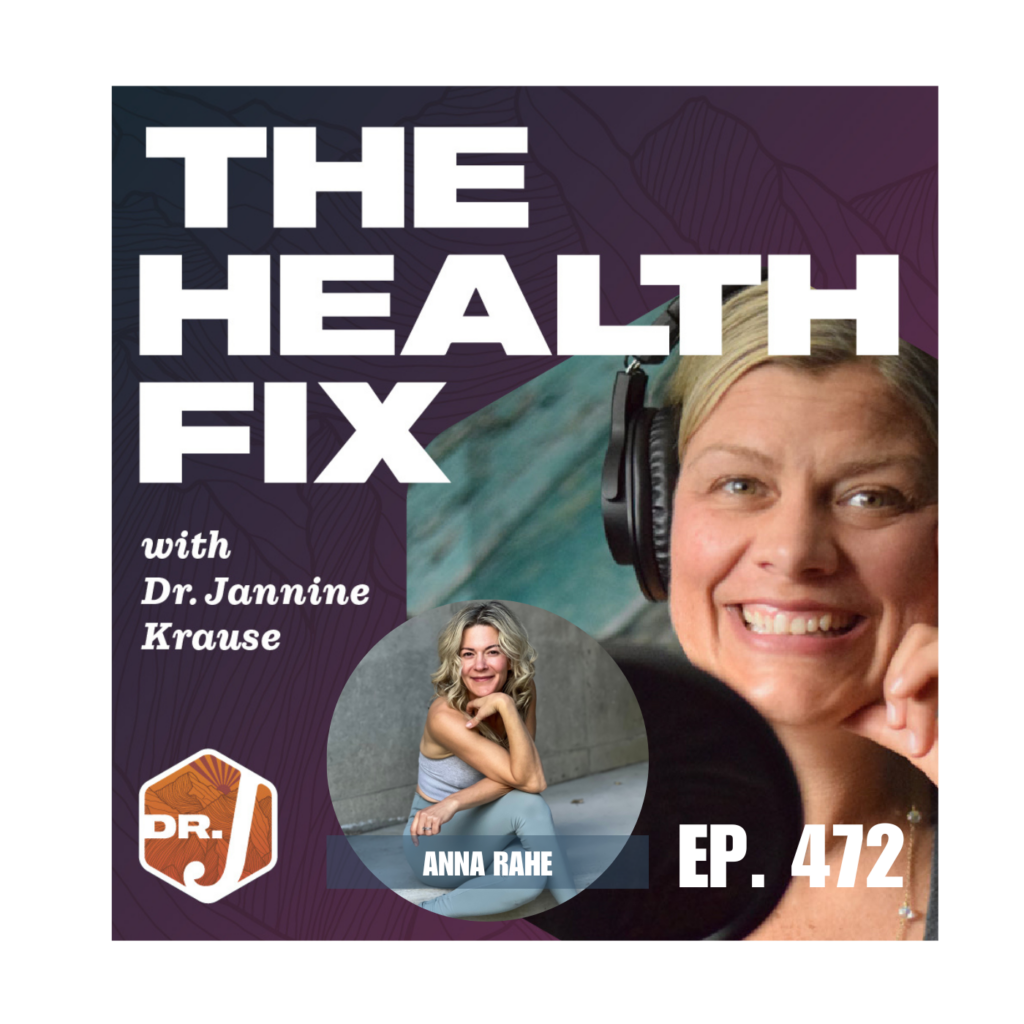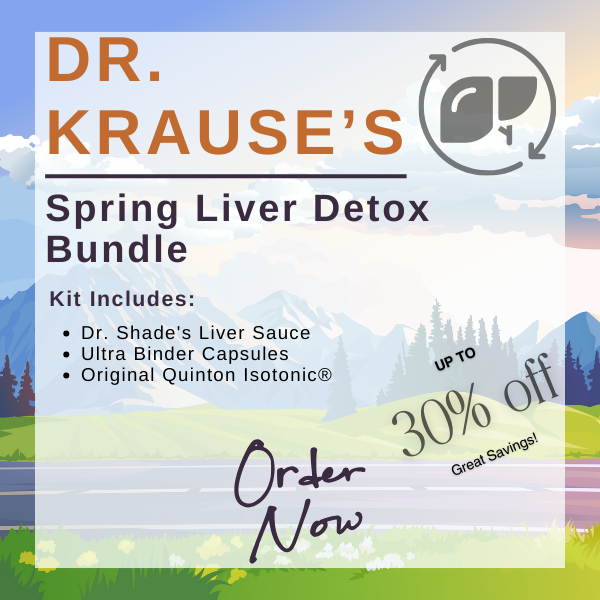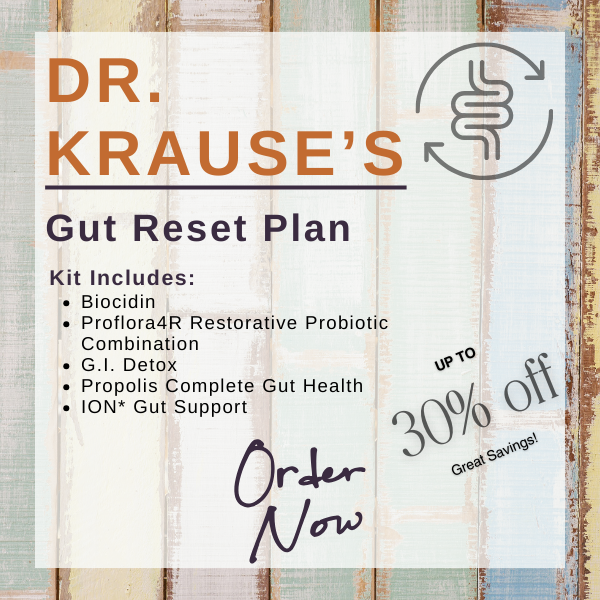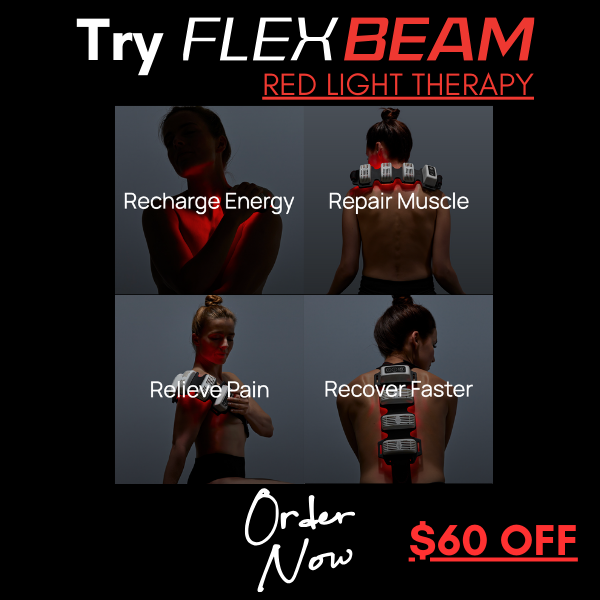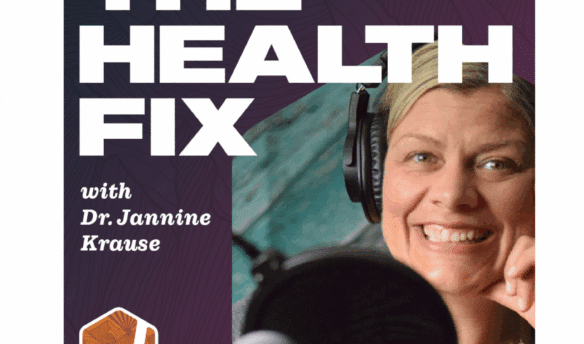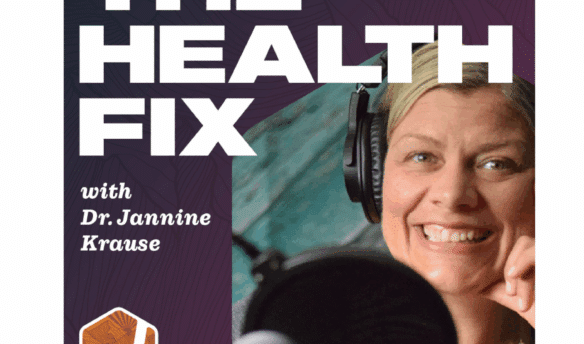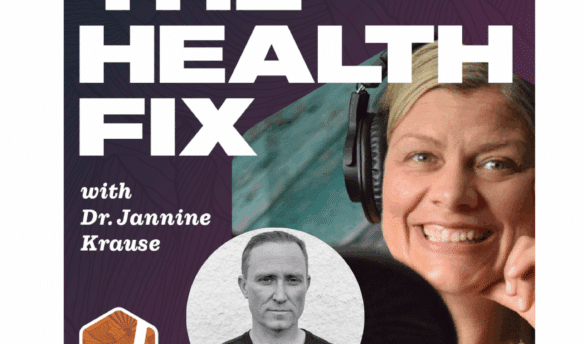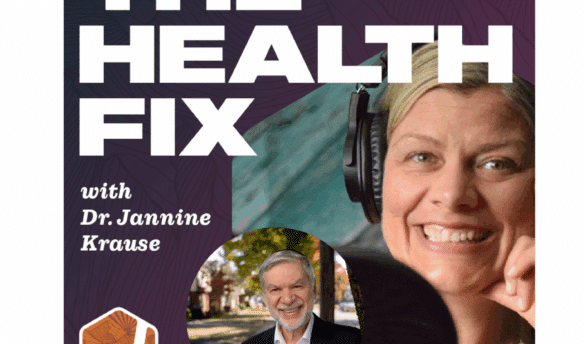At 18 years old Anna Rahe felt like she was 80. Everytime she went for a run or hike it would take days for her to recover. After being told her situation was a mystery, Anna went on a mission to figure out what was causing her fatigue and pain. Fast forward to today and Anna is the CEO and founder of GST Body, a proprietary system known as Gridflow Somatic Technology. GST is a way of remodeling your fascial tissue to hydrate, condition and revitalize it. Anna has partnered with top athletes, surgeons, physicians, and celebrities, as well as being featured in various publications, from Shape to Elle, Net-a-Porter to The Wall Street Journal. In this episode of The Health Fix Podcast, Dr. Jannine Krause interviews Anna Rahe on the latest research in fascial tissue and how it ties into your fight or flight nervous system, mobility, energy making capability as well as your capacity to recover from inflammation in the body.
Dr. Krause’s Protocols
Instructions Included
Traveling soon? Looking to detox or reset your gut? Try one of Dr. Krause’s Fullscript plans.
What You’ll Learn In This Episode:
- The functions of different types and layers of fascial tissue
- How body uses electrolytes in fascial tissue to communicate health status of the body
- The connection between gut inflammation, fascial tissue communication and constipation
- Why fascia is a great place to evaluate when you have mystery symptoms
- The potential of a fascial microbiome
- Unhealthy fascia and cancer connection
- Mixed connective tissue disease and it’s roots in fascial tissue
- Reassuring your body it’s safe with specific fascial movements
- Difference between foam rolling fascia and movements to control fascial contraction
- Benefit of primal squatting and swinging motions on your fascia
- How traction of the tissues discharges stuck pain and fight or flight energy

Resources From This Episode:
- Anna’s Website – annarahe.com
- Anna’s Fascial Training Website: gstbody.com
- Instagram: @annaraheofgst and @gstbody
Our Partners
Podcast Transcript
3:04 – What is fascia?
7:32 – The energetic smart grid
9:20 – Fascia’s connection with health mysteries
15:13 – What are luo channels?
24:01 – Grid flow, somatic technology – GST system
27:59 – More about Anna’s work with fascia
33:33 – How do you know how damaged your fascia is?
41:14 – Example of what you will find in Anna’s program
44:09 – Fascia macrodosing every 45-60 minutes
51:49 – Where to find Anna online
[Intro] Hey, Health Fix junkies. It’s Theresa Lear-Levine from Becoming More Me, the podcast for busy-minded
entrepreneurs that want to be more and do less.
Blessed to have appeared on not just one but three episodes of the health fix.
So I encourage you to check out episode 445,
411 and
322 of the health fix podcast where I talk about breaking up with your old self, self-sabotage,
fears and thriving through life’s changes.
Mm, perimenopause, using EFT tapping and hypnotherapy.
You’re listening to the Health Fix podcast.
Here’s your amazing host, Dr. Jannine Krause.
JANNINE: Hey, health junkies.
On this episode of the Health Fix Podcast,
I’m talking with Anna Rahe,
and we’re chatting all about facial tissue in a way
that I haven’t talked about it before.
As a doc who does bodywork and acupuncture have come to realize that our wrapping, known as
the fascia or fascia tomato tomato, is so much more than wrapping.
And with the rise of gut, thyroid, and autoimmune conditions, and in particular, the autoimmune
condition makes connective tissue disease.
I believe that fascia tissue has a role in the health of our glands and organs.
Anna and I will dive into autoimmune conditions and in particular,
the mixed connective tissue disease in the podcast.
But before we go there, let me tell you a little bit about her.
Anna is the founder and CEO of GST body.
It’s a proprietary system known as grid flow,
somatic technology.
GST is a way of remodeling your facial tissue to hydrate condition
and revitalize it.
She developed this system as a way to restore her health after feeling like
she was 80 years old at 18. What the heck? Anna’s passion is evident in this podcast,
and I learned a ton about facial tissue that I didn’t know. So I’m certain you’ll get some new
insights from how your tissue loves traction, so that pulling on it, rotation, swinging,
pendular motions, and you’ll even learn a little bit about the interconnection between your vagus
nerve and facial tissue and the idea that there may be a
facial microbiome just like the microbiome in your gut.
What? So cool. So I have no doubt that you will enjoy this podcast and get a
new perspective on fascia. So let’s introduce you to Anna Ray.
Anna Rahe, welcome to Health Fix Podcast.
ANNA: Thank you. It’s so nice to be here. Thanks for having me.
JANNINE: Man, we had such a great conversation before. I probably should have hit record,
But hey, that’s all right guys. We saved some good stuff for you
Like one of the big concepts that Anna was talking about that I never really thought about before
Was that this whole?
fascia thing is not just wrapping is a system with its own organs
And so people are gonna be thinking like organs, Anna a do-tell.
Tissue organs. What is this stuff? What what are you talking about? So give us a scoop? ANNA: Okay?
So I think the best way to think about fascia people kind of have a general idea
but it’s kind of like a body fabric, like a kind of textile.
It’s woven, it’s like fibrous, it’s called the fibrous net.
And so when you refer to fascia, you’re referring to the type of tissue,
but this fabric organizes an entire body system.
It’s called the connective tissue system.
And it comes with its own organs, like your digestive system has a series of organs
that process everything and your endocrine system has all these glands and organs that process things.
So the connective tissue system does very specific things.
And it’s organs wrap around every other body system in and out,
facilitating different things, different functions on every level of your physiology.
So I like to look at fascia and I use those terms inter-exchangeably, right?
Cause everyone’s talking about fascia because it’s easier to say than the CTS or
the connective tissue system.
But I like talking about it in this like kind of globalized view because it has
way more significance to our total body health than just thinking of it wrapping your muscles
or wrapping it. It’s so interesting. The mind kind of still wants to compartmentalize.
And these organs, a way to think about them is that they’re not masked organs, like your liver,
your heart, your lungs, those are masked organs. And those are really interesting in anatomy.
You open up the cadaver and it’s like, Oh, look, what is this? What does it do?
And fascia has kind of been disregarded over centuries because it seemed superfluous.
It was like everywhere like cobwebs inside of you, gooey gel cobwebs that are everywhere.
And they’re like, “Oh, this is just stuffing.”
But they were missing. There’s an organization to fascia.
It’s just not masked. It’s layered.
And so you almost want to picture like a bucket of white paint and you put a drop of red in it and you stir it.
Fascia would be the string and the fibers of that plane that’s kind of like moving through the paint.
And so when you look at it in your organs, it dives over certain organs and dives under
other organs and wraps around.
And so we start to try to look for patterns more in like a kind of sedimentary or like
a layered way rather than looking for chunky items and fascia fact works best when it’s
not chunky, when it’s not masked, when it’s not fibrotic, you want it to be extremely agile
and um, individuated fibers, individuated rather than masked up. It’s kind of a different system
in that way. So, uh, that’s the big picture anatomically of what fascia is versus what the
connective tissue system is and how they serve, um, they kind of work together, but like you have
your viscera, which is the connective tissue and fascia of your organs. It’s kind of like a textile
that’s like slippery and slimy, a little bit more like septeen.
Its consistency is very much all about being able to glide and push and work with peristalsis,
the actions of motility of your organs.
And then you have the myofascia and it’s kind of like Gore-Tex.
It’s like rough and aggressive and it can handle high load and high friction because
you wear it every day when you move in your muscles and in your bones.
And then you have the way the fascia layers over your nervous system and in your endocrine
system and they’re all slightly different textiles, loose fibers, broad fibers.
And that’s all based upon energy output of the organ and how that energy has to be modulated
to keep the whole symphonics of body energies moving.
And that’s the connective tissue system is a communication system.
If you look at it as a system, it’s a body wide communication system.
It’s a hydration and irrigation system.
how all of our cells actually extract and get the water that it needs to give life into our molecules.
It is a transportation system. It’s how actual nutrients gets through into the deeper layers of
cellular function. It’s an animation system. It’s the primary way your body comes to life. It used
to be thought that muscles and bones pull on each other and that’s what initiates, but actually
it’s fascia that contracts to pull the muscle into action. So it’s like our foundational animation
system. And so when you take all of these kind of components of what it does, it’s greatest service
is that is your energetic smart grid. I don’t know if you’re listeners or if you’re familiar with
smart grid technology. There’s a great definition that I can actually supply. I can’t do it by memory,
But like the smart grid is this really interesting network of energy regulation, taking high voltage
and low voltage and modulating it into this kind of like usable, friendly, collaborative,
connective network. And it’s self-sustaining and it’s self-operating, it’s also self-healing.
And so, fascia and the connective tissue system does that for your physiology and your carbon
in life form the way that it does it on the planet.
And so it becomes a really serious problem when your fascia gets dehydrated,
stuck, non-individuated.
All of a sudden your entire body can’t send electromagnetic and
electrochemical transport, which is what keeps us alive.
And so I like to first talk about it from this like global perspective.
And then we can dive into like all the questions that people have like,
Well, how did I know that this didn’t exist?
And what do I do to take care of it?
But I think that it’s important that people just know
that this is actually super significant
to kind of like the hidden things.
We have something common, you and I,
that a lot of the body problems that we started facing
were very mysterious.
It’s like, why?
Why do I, all of a sudden I hit 40 or I was 18?
I was like, why am I so sore?
I can’t fucking move.
And I didn’t do a workout.
Why do I go running one day and I am like super athletic
and I can make pace and I’m doing great.
And then two days later, the same run
feels like I’m a 10-pack a smoker.
Like I cannot get up this hill and I feel so bad.
Why do I have all these IBS symptoms?
Why do I have these like, it’s like these multiple symptoms
and it was like this mystery like, what?
And so fascia is a fun frontier because for the person
who has tried a bunch of things
and done all these options, fascia is like, wait a second,
here’s maybe a new worldview.
Here’s the 360,000 foot perspective
of a new thing to consider in that health equation, right?
And what we can think about and include in our understanding,
and then all of a sudden it’s like, oh,
they’re not separate specialties.
My gastroenterologist told me that it wasn’t a,
you know, respiratory problem,
but I actually know that that’s really connected, right?
So the connective tissue system will have multiple symptoms
and it’s a good place to go into the mystery
of if people have health mysteries
and wanting to fix something that just won’t go,
fascia’s a really great place to dive into.
JANNINE: I agree, I agree.
It’s definitely one of the places that I’ve gone to
with myself and with patients
when we’re trying to figure things out.
Now, one of the things I didn’t mention
before when we were talking earlier
is that I’ve been seeing a lot more
mixed connective tissue disease.
So the autoimmune connection here, like autoimmune stuff popping off left and right.
And folks having like a chronic gut issue or a chronic, you know, this or that issue.
And I’m going, I can’t help but think that that’s not a really.
Yeah–
ANNA: it is.
It is. Fascia’s deeply ingrained.
In fact, I was talking to one of the researchers the other day in Germany.
And we were talking about this fact of like the there’s they’re starting to define
a facial microbiome, which is, yeah, which is deeply connected. It’s the extrinsic versus the
intrinsic microbiome that’s inside the gut. And the relationship between these shared,
you know, stasis of what is happening in these zones and that one of the things that they have
in common is that static, okay, I have to kind of back up for just a minute. The way fascia
functions is kind of like a sponge. It’s kind of like a pump, a hydraulic pump that actually needs
to compress and release. Think about almost like, you know, the Great Barrier Reef and the coral,
right? How there’s these sea anemones that push and pull fluid through. And so,
Fascia and your parasols of your organ are your more like pumps than you are like
sticks and bones, right? A new body perspective. So we’re like this big living pump that needs to
to be moving and these microbiomes require this phalangial kind of motion that is 100%
facilitated by fascia.
And so when our fascia stops being animate, we have a huge like septic condition for disease.
And that’s like inflammation will can like, I don’t know what to say, retard, produce
the amount of phalangial kind of like activation and animation in fascia.
So is dehydration and there’s kind of like this interesting reverse relationship between
inflammation where you can, inflammation will cause damage to the fascia, but fascia,
unhealthy, will leave the body septic to higher levels of inflammation because it’s not spreading
and sharing and hydrating and moving these elements inside those microbiomes. So it’s a very interesting
like kind of internal ecology, right? Of body, body ecology.
JANNINE: Wow. I never thought about that. And I’m sure a lot of people are like,
“Whoa, microbiome there too, my goodness.”
ANNA: That’s right. They’re all these little systems that keep us, you know,
in check. That’s an interesting thing about fascia too,
is that fascia like offers the boundary lines between really important systems
that are supposed to be separated, right?
So for example, we have the brain blood barrier or something, right?
Isn’t that what is called the brain, something barrier?
Nothing’s supposed to get to your brain.
Nothing’s supposed to get to your brain because it’s supposed to be isolated because it’s got
really specific things it’s supposed to do.
And so fascia, when you look at it in the human body, it’s almost like a netting that
offers like compartmentalized orientation.
So this is where some of this research comes into tying it into cancer and metastasis of
of cancer is that cells are like certain cells are supposed
to stay regional to certain areas in the body,
rather than migrating into other areas.
And unhealthy fascia, when it’s not like a netting
and there’s adherances and like fibrotic conditions,
create almost like a skate pond,
where a rogue cell can come over and actually skate
and move in the pre-lymphatic fluids
to a new area in your body.
And so you want that fascia to be like,
Okay, these are the protecting of these regions.
And these, you know, have you ever studied,
this is actually something I wanted to ask you,
segmental anatomy?
JANNINE: No.
ANNA: Okay, I found this book
and it’s very much part of acupuncture
is where I’ve seen it connected to,
but it’s a way of looking at the body segmentally
by like embryonic development or something.
And I don’t wanna go too deep for your–
JANNINE: Oh, okay, I see you’re doing okay.
ANNA: It’s just really interesting and I,
they don’t really talk about fascia in the book,
but I am like, I feel like if someone was looking
at segmental boundary lines, they would start to see
the peripheral containers of the factual organs
and start to see how energy is being passed
and there would be a metabolic process inside of that
of how fascia is feeding things anyway.
So I wanted to geek out with you just for a minute,
but I thought maybe as the acupuncturist
and integrations that was a required reading
that you might have.
JANNINE: No, probably something based off of embryology
and then how that weaves into things we call luo channels.
Like those is what that would be.
Have you heard of Luo channels?
ANNA: No, but I want you to tell me about it
because one of the things that I keep looking for
when I’m like doing my acupuncture treatments
is I don’t experience fascia in lines
as much as I feel them oftentimes in planes.
And my acupuncturist is the only one who’s been able to kind of voice this to me and I wanted
to know if you, what, I guess there’s neurological plane or meridians that actually like dive
into different neurological planes or something.
JANNINE: Yes.
ANNA: Can you elaborate on that so that I have a better vision of what that is?
JANNINE: Yeah.
So what happens?
They call them either either muscular.
So there’s muscular kind of connections to the channels.
And then there’s also things called luos.
And then there’s also like other different source points and G cleft points,
which are, which are for the folks who are listening before you guys are like,
what in the world is she talking about?
These are little points in our body that connect in as like alternative
meridians that dive into yes, muscles or dive off of so divergent channels is
what they’re also called.
They’ll diverge off of a traditional acupuncture channel and dive into an organ.
And so I think this is, is similar to what you’re describing,
because when we looked at the higher level picture of it,
we were talking about how embryology
and how our mesoderm, so this is our muscle tissue guys
and the nerve tissues, which I’m not gonna remember,
all the names now tie into the ear too and auricular.
So I think that’s what you’re describing
in the different diversion.
ANNA: Yes, yes.
I mean, I have not read the entire book.
It’s like anatomy book, and I just kinda like,
I don’t know all of the terms,
And so I get a general sense, but it was really,
I’m always still looking for,
so most of my stuff with fascia
came off of personal experience.
Like literally I would spend hours internally channeling
and like being like, okay, it got stuck here.
And then this blew up and then I got this sensation
and I literally did it kind of like,
I call it body braille where you just go inside
and you follow sensation.
And so when I ended up getting an anatomy book
on fascia, “Fascial Anatomy Trains”,
I looked at it and I’m like, yes, yes, okay, yep, yep.
And 90% of what I experienced was there,
but there was a, I would say 70% of what I experienced
was like on that I could see.
And then I’m like, but they’re not covering this.
And I think that it’s this, it’s almost like,
did you ever see, oh my gosh, I’m not gonna,
my cultural, I was raising the 80s like you were,
but my cultural references, there is a video game
that was made into a movie.
But the reason I’m bringing this up
that the visual of what I picture fascia to do is like where you’re they’re writing these
like things and on one plane that’s all grid and then it drops down and then it goes to
another grid and then it comes up and and they’re in this geodesic kind of atmosphere
but then they’re diving in and out and and this is what I’m picturing in terms of the
spaces in between it’s almost like interstitium is another or in a fascia that’s layered and
and being able to drive.
Anyway, I don’t want to geek out too much because I know that that’s not as helpful to
listeners who are like hearing a different zone, dude.
Can you come back to where I am?
But I think why this is important is that there’s this massive organization that is
connecting everything and it’s asking us to review the things we’ve currently thought
about anatomy and how the — and even the sciences that we’re applying to it to take
care of our human body, right?
Example that I have is that we use solid mechanics as the primary physics to look at
biomechanics, okay?
So when we look at the human body, we see pulleys and levers and, you know, all of these solid
types of, it’s called solid mechanics.
And fascia’s 70% water.
And that water happens to be this like gel type water.
it’s a new state of water that they’re starting to research.
And this new state of water is highly conductive
and it has struck, sometimes they call it easy water
or structured water.
And this water has specific behavioral things that it does.
And so all of a sudden, when you start looking at movement
and how the body is, you’re more like a water balloon
flying through space, then you are,
Okay, this solid pulley system.
The reason this is problematic
is that all of our physical conditioning that we do,
we’ve kind of dipped into damaging, okay?
And we can talk about the things that really damage fascia.
But our biomechanics, the way we move,
the principles of like trying to build a solid core,
we look at the body and we see lack of stability
as a liability.
And it’s like, wait, the gospel of stability
has always been like, tighten things and tone them
and make them more rigid.
And it’s like, fascia is like, ah, ah, ah, ah, no.
I need to have like all of this incredible pulsation
and motion that’s going through me in order to do my job.
And so we look at the two things that damage fascia,
sitting all day and over working out
or the way that we carry our mechanical loads, right?
So if you’re a big worker outer
and you’re always like, why am I so tight?
And why do I feel like no matter how much I stretch
after a workout,
I can’t like, you know, why we were just talking about this
are the chronic, you know, illnesses
in the muscular skeletal system that show up
frozen shoulder, right?
Like limited hip rotation,
disappointed or displaced dislocated discs in our spine.
It’s ’cause everything, so viced down,
everything is so into this solid, solid body model
rather than fluid body model.
So fascia kind of like,
Flicks on the light and is like, hello, world is not flat, world is round, world is not sticks and levers, it’s pulleys and I mean not sticks and pulleys, it’s pumps and valves and all these three dimensional, you know, things.
So then what you need to take care of your body drastically changes, right?
[Advertisement] Hey, health junkies.
If your feet aren’t happy and healthy,
the rest of you could suffer from low back pain
all the way up to neck pain.
And yes, even gut issues can be related to your feet
because your feet are connected to your nervous system.
Happy feet equal one less thing
the nervous system has to worry about.
I wanna tell you about Peluva.
This is a new zero drop minimalist shoe
with a distinctive five toe design.
Peluva’s give you the most authentic barefoot style
experience, but with sufficient cushioning to use in everyday
movement fitness and athletic activities.
Peluvus are super stylish.
So you also get a barefoot shoe that looks good too.
Peluvus are a step ahead of every other zero drop Y box shoe
because they feature separate slots for each of your five toes.
So if you’ve been using toe separators, you can ditch them and just wear the
those individual slots for each toe allow for correct dynamic movement of the foot
through the walking or running stride, which is important when toes are encased
in a single box, even a wide box. Now minimalist shoes have faced controversy
in recent years about causing injuries from inappropriate use. So you want to get
walking in polovers, living in polovers, and doing whatever you can while you’re
going barefoot in your home and safe areas as much as possible. So go ahead and use your
specialized running shoes, basketball shoes, work boots, high heels when you need to,
but wear pulavas as much as possible to reawaken the natural functionality of the human foot
to stand, walk, run and perform. Try a pair of pulavas with no risk and you’ll quickly
realize that these are the most comfortable shoes you’ve ever worn. They’re designed
to feel like you’re walking barefoot on clouds.
So visit polluvape.com and take 15% off
with the code HEALTHFIX.
Let’s get back to the podcast.
JANNINE: Yeah, yeah, it’s a whole different thought process, right?
Compared to our usual crank on things,
stretch until you can’t stretch anymore.
You know, thinking about it, that’s different direction.
So of course, I’m curious if how you’ve described the different pumps and whatnot, as well as
describing the different grids, is that what created the grid flow, somatic technology,
GST system?
ANNA: That’s a really good question.
JANNINE: Is that where it came from?
ANNA: So yes, that’s where it eventually went to.
It was originally called Grace Somedomorphic Technique.
It started because at 18, I was part of three legal battles in the Pilates world, and
I met with a lawyer and I’m like, I think I’m doing something different with GST.
He’s like, make sure you name it something that no one else is going to use.
Well, no one else remembers it.
I chose something so creative that it didn’t really work.
So it wasn’t until probably 2010 when I was like, this is really describing its grid flow.
You’re smart grid and the needs keep it in flow.
And it’s technology because there’s this interesting element of fascia that people, even in manual
therapy disciplines and stuff are not tapping into.
So I experienced this early on in my journey that fascia has the ability to contract, it
has cells that are contractile just like in a muscle.
They’re not as powerful.
So it’s like the muscle contraction cell that makes it like contract to move you is 10 decibels
of power.
A facial contraction is like a decimal and a half to two decimals.
So it’s very subtle.
There’s a very good reason for this.
Science is still like, we don’t know what the importance of this is.
And I said, well, let me tell you something.
It works on–
fascia works on the back side of your physiology.
If the fascia in your eye pumped like the fascia in your muscle,
like the muscle contraction, it’d be like having a gelopy
with like a 10-pound base in the back.
Your body would just be like constantly overstimulated
with contraction, okay?
That is not what is happening in our bodies.
It’s really lo-fi, right?
fascia is very lo-fi.
But here’s what’s interesting.
When you contract fascia in patterns,
kind of like muscle groups,
there’s facial groupings by their layers
and by their regions.
And when you contract them and organize them together,
they’re quite powerful.
And they actually are what synchronize
all physiological and gross motor and anatomical movements.
And so this is why I’m really passionate about it
is because you can, by controlling your
facial contraction, you actually have more
autonomic access than previously thought
because fascia is deeply wired
into your autonomic nervous system.
And so you can choose to create impulse,
kind of like when you put an electro pad on your arm
your muscle contracts, but you do it inside you.
It’s an inside job.
And all of a sudden, fascia that’s stuck, rolling it is good because it gives hydration,
but it doesn’t actually send a impulse for the fibers to spread and distribute.
And this is where we start getting to the technology of what is in GST is, if I teach
you those patterns and how to contract your fascia, those things, you can have really
specific control over many of your physiological functions that you didn’t think.
It’s not just a matter of the state of your tissues, it’s how is it animating the function
of your tissues, right?
Not the condition of it.
One proceeds the other, but there are separate issues.
JANNINE: Never thought about that before.
And you know, we’ve kind of, for baseline, you know, treatments, yes, you think about
the foam roller, right? Or you think about you had mentioned before the blaster.
So let’s talk about a little bit about like how you’re incorporating something a little bit more,
the blaster, well, that’s another conversation. But the, you know, like the different balls,
like the melt theory kind of stuff, the foam roller, you know, you’re hydrating, you’re moving
things. But how do how are you taking it to the next level? Tell us what you’re up to.
ANNA: So two things people need to know is that fascia is chock-a-blockful with more sensors than any other tissue in the human body,
which means that it can receive a ton more information, but it also means that it needs all kinds of different stimulation in order to really be activated.
So when you look at the way that we are approaching fascia, all of them are doing fascia.
It’s kind of like the analogy of the elephant in the, like the religion.
Everyone’s touching a different part. It’s like, “Oh, the Buddha said it feels like a tail.”
And the Chinese, you know, the Confucius say it looks like you’re tusks. And so everybody’s
kind of touching it. And that’s kind of what’s happening in fascia because it’s really new.
And everybody’s like, “Oh, but it feels like this to me or it works like this.” So you have
compression and it feeds a certain receptor, a mechanoreceptor, and it creates an impulse,
the same kind of impulse. You’re stimulating it from the outside and it releases.
It gives you certain benefits like hydration, like
individuation, okay? But it doesn’t actually change
remodeling structures, okay? The remodeling is what I was really
interested in. My body was so messed up and it was so
structurally fucked up. I had had rulfing, tens and tens,
but I would get in there and they would do the work on me and then I would go out
and dance and everything that I got in my 10 session was gone within
two weeks because this comes down to the approaches that movement supplies all of the requirements
of fascia to remodel, to be healthy, to be hydrated, to have glide, but it also
offers you much more opportunity. You need duration and you need repetition to create change in fascia.
And this is where the it feels good to go have a massage. I don’t think that taking it away from
body workers is the goal. But the idea is that a body worker you see once a week and or if that
once every two weeks, they see you for an hour. There’s no way that they can counteract the damage
that you’re doing. Well, what are you doing the most of? You’re doing the most of your daily living,
which is motion. And so it just so happens that fascia is like, motion is what I do. Motion is
actually a metabolic process of eliminating static tension from the system. It is the same
thing as a detoxifying experience. We don’t create it that way because we always focus on the loading
in because load makes you strong. Load makes you connected. Load is what stabilizes you.
And fascia’s like stop loading me with shit. It’s like eating too many calories or taking too
much sun on your skin. Fascia says, start expelling the testetic energy that is in the system that’s
It’s like seizing me.
If I get an impulse of too much load in my shoulder,
the muscle gets lactic acid, it shuts down,
it contracts, and it can’t release.
So then we go to the massage therapist,
the facial, myofascial specialist, we go on our roller,
we get it to kind of ease out.
But what happens if we didn’t get that problem
in the first place?
What if we didn’t load it incorrectly?
What if we didn’t move it incorrectly?
And so then this comes down to this idea
of you becoming your practitioner.
Do you know that every person working on your body,
and this is happening even if you’re rolling
on the foam roller, is using only three tools.
A lever, which is like a stick,
to apply force to get flow.
Chiropractors put all of your bones, levers,
into a configuration.
They put force through it to get a pop through the joint.
They’re focusing on the skeletal system primarily,
nervous system secondarily.
Massage therapists use their levers of arms,
and they push into your tissue trying to get flow.
An acupuncturist uses the lever of a tiny needle
into the meridian to get the qi to flow.
Okay?
Everybody’s using these three tools.
Well, cool.
Your anatomy has all of those.
You have a system of five different levers,
spine plus four limbs.
They can divide it into segments
and you can direct and learn how to apply your force
with really great specificity and precision.
And then you learn how to contract your fascia,
which is the primary organ of flow
that sets the precedent of all flow.
So what we do in movement is we start to teach people
at different biomechanics.
Here, good example.
We always teach shoulder-girdle stabilization
by pulling your lats down and pulling your shoulders back.
Down and back.
Well, just, I have my favorite saying is just
’cause a lat moves like that doesn’t mean
it should be used like that.
Well, lat is actually supposed to load in
and push energy out when you start looking at it
from a fascial perspective.
It’s supposed to take the load
and then eject it out as far as it can.
You need more traction in your shoulders
than you need depression.
But our solid mechanic says,
ooh, we need to stabilize that shoulder girdle.
That is why you’re having frozen shoulder.
And it’s like, no, you’re having frozen shoulder
’cause you’re pulling your ribs down to your core
and you’re submerging your savagal down
rather than creating suspension and lift
and levity in the body.
We’re like adding to the liabilities of gravity.
And so when you look at your body care
through the fascia lens, you have to use motion.
It is the most potent.
It supplies all of the loading, the directional force,
but it’s also providing duration and repetition.
And so it’s the primary conditioner of your fascia.
So if you’re gonna wanna heal your fascia,
what you do during your day cannot be repaired
by simply, it can be helped, but not repaired
by how 30 minutes of rolling, right?
And so then you go into how do you know
how damaged your fascia is?
And there’s different levels, right?
There’s genetic, there’s disease related on the spectrum.
And then there’s like,
I’m kind of pretty highly functional,
but I get tight if I do many too many squats, right?
And inside of that spectrum,
some people need way more like potent
and concentrated care of their fascia.
And other people,
foam rolling is perfect.
They just need a little elixir, they need a little ocean, and they’re good to go.
But that depends on body, you know, body type, tissue type, and then body liabilities.
Like, you know, people who are super active like you would have a greater liability because
probably your biomechanics are not great.
Even if you are doing them the way that you’re, let’s say that there’s two fields.
There’s like, you’re taught this, right?
when you go to a trainer or a physical therapist,
they all teach this.
Solid core, keeping your shoulders down and back.
These are really foundational, I call them junk moves,
but they’re like junk food, they’re bad for your body.
Think about what happens in your lymph system,
just as a side note, when you pull your shoulders
down and back, you are compressing the lymph,
but they’re never given room to actually flow.
To move your lymph, it’s not just about activation,
it’s about circulation.
The activation comes from compression,
circulation comes from tractioning. And most people don’t do enough tractioning in their
movement, like pendular movement to move lymph. So you go to your massage therapist and she
pumps on you and then she kind of moves it, but it never gets to this full range of like
hydraulic motion. And so these are the kind of things that we need to just start rearranging
our thoughts about if there’s an area I can’t get to, go to your practitioner, but take
some ownership and be like, if I just do these kind of things, I can really actually
have healthy fascia, which in turn will change my digestion, my internal microbiome.
I will ease my conditions of Crohn’s disease and, you know, diarticulitis afflictions and
right?
There’s all of these, you know, they’re not even secondary.
They’re really primary ways that fascia will eliminate stresses on the body.
JANNINE: Oh my goodness.
I mean, I know so many people who it’s come like their IBS or their like supposed SIBO,
which is is they’ve taken every supplement under the sun and they’re not getting better.
And we start working on rib cage and we start working on pelvic floor and rib cage pumping.
And then we start working on opening up things.
And yes, this traction thing you’re describing.
Is that why I like to hang on my bar over head and just like let myself hang out?
ANNA: It feels so good.
JANNINE: Yeah.
Crave traction and we never get it. Right? So what I’ve tried to like really take science
and make it simple because most people don’t have the bandwidth. I like to go deep,
but most people don’t. And so when you look at how fascia’s organized, fascia itself is organized
in tubes, okay? From the cellular fibral of the fascia to the actual structure of how it wraps
around on a micro level into the macro level of a sheath around the myofascial envelope or
I was stocking, I like to call it stocking.
Not an envelope, envelope of square, muscles around,
whatever, I don’t like using the same terminology.
But when you look at that, you’re like, okay,
fascia needs something very specific.
And it’s a syringe-like motion.
And I’ve simplified it down to this.
If you picture fascia like a tube
and you know that it follows the laws of fluid dynamics,
not solid mechanics, fluid dynamics, different physics.
different branch. You have to picture a syringe because it’s the most simple
like a now is the most simple example of fluid dynamic hydraulics. I pull the
syringe water comes into it, I push the syringe water goes out of it and then
there’s one extra action for fascia which is rotation. Okay, these are the
three foundational principles that fascia needs constantly in motion and
every anatomical movement we have in the human body is one of those three things. We call it
flexion, extension, and rotation of the spine. But if you look at it from a three dimensional tube,
it’s actually like an accordion, compression, traction, and then torsion. Okay, those are the
three forces that are moving fascia. So when you start looking at human movement, you need to be
be like a sponge or like a syringe where you compress, you then traction and then you
rotate it out. And the way that I like to picture it for people is it’s kind of like
washing the fibers of a beautiful sweater. You dunk it in the water and agitate it. That’s
the compression. You bring it up and all of the water and the dirt falls off of it and
then you rotate it out to get the final detoxification. And so when you look at like primal squatting
is the most foundational movement that is healthy for every single organ in your body and its
compression. It’s loosening fascia. It’s not tightening it, right? Pichy, you know those Chinese
finger toys from the 80s where you put your fingers in each end? So that is literally how
fascia is. It’s like woven and it’s a tube and you stick your fingers in and if you push them together,
it loosens and you get all of this space and then you pull it and it gets tighter. This is how
fascia actually allows us to gain strength and stability without rigidity.
Is that it pulls long and it kind of holds you like a sling.
And then you rotate and it does it.
So if you look at, I don’t know if you’re familiar with this, rotation in the body happens on
the bilateral rotation of the pelvis, which turns the spine, which turns the shoulders.
And that’s the rotation that’s on micromovament that’s like literally stirring the tissue.
So you’re walking, that’s compression.
We rarely get traction.
We need more traction, but that happens through breath.
And then we, right, that’s the pedestrian version.
And then we rotate as we walk.
And those three elemental actions should just be taken as a, the, the baseline for what
we look at is in exercises.
And if we look at exercises, we are super malnourished.
Nothing that we’re doing in our exercise movement, that’s the only movement we get,
in our exercises is dynamic enough to make us have all of these elements that fascia
needs and think about fascia like fabric. It needs to pull, it needs to dunk, it needs
to, right? And then all of a sudden your fluids are moving and you’re not a septic river mess
of disease. So those are the things that fascia needs in a simple science to taking care of
your body and that’s how the basis of our technology works is using those fluid dynamic
principles to apply to movement.
So you can manipulate your tissue.
So movement becomes tissue manipulation for the purpose of remodeling for any level of
health that you need.
JANNINE: Makes sense.
I mean, it makes sense.
Something like exercises in general, it’s usually forward and backward motions.
It’s usually flexion extension rotation every so often we get something, but it’s not all
at the same time.
most people are not breathing.
In terms of the whole pumping thing,
some like, okay.
So I saw online that you had your tools, right?
And there’s lots of traction.
And I saw you kind of in what looked like a Pilates
kind of V of sorts.
ANNA: Like a good true V in shape?
JANNINE: Yeah, yeah.
So give us a little scoop,
like how you bring it all together, if you will.
So folks can kind of have a visual of like,
okay, we’re tractioning, we’re pumping, we’re moving,
We’re turning, we’re, yeah.
ANNA: I’ll try to describe it to you.
So I think I like to describe it two ways.
Number one, fascia really likes,
like life is a jungle gym, right?
Diversity of motion, wide ranges of motion,
and it really loves microdosing.
It does not want you to go out for 60 minutes
at the end of your day of sitting
and trying to pump it full of goodness
because it’s already got glycation.
It’s already got sticky, honey restriction on its fibers
from sitting all day.
And then you go out and you burn it
and scorch it with high intensity workouts.
And it’s like, you just went out to the Mojave Desert
without sunscreen on and sat out and got, you know,
in the beginning of spring, right?
Your skin’s like, oh my God, this is not good.
It’s a similar experience for your fascia
of just being like, burned.
So it likes microdosing.
Every 45 to 60 minutes, you should be able to look around
and find holes, find handicap ramps, find railings,
find park benches, find your door
while you’re at a gas station with the window down
and start tractioning.
You grab onto the surface and you just hang back.
Whether you’re doing it from a, like a pull-up bar
or whether you’re doing it from, do you apply,
do you put video with your podcasts?
JANNINE: Yes.
ANNA: Okay, let me just describe it
and then I can just show it.
You literally take first thing in the morning
And then you’ll apply this movement to your jungle gym.
Everywhere you go through your day,
you’re gonna look for places to hang and play.
Your body loves to play, okay?
So you go, first thing in the morning,
put your toes against the baseboard at your sink.
Grab onto the sink and stretch your butt back with bent knees
as long and as far as you can.
You’re gonna rip that sink off the wall
and then you’re gonna drop your butt into a compression.
And then you’re gonna pull back your butt again,
like a slingshot,
and then you’re gonna drop your butt into compression.
This is the most elemental.
It’s easy to do off a filing cabinets.
It’s easy to do off a sink when you’re walking out
of a bathroom when you wash your hands.
It’s easy to do when you’re waiting in line at a Starbucks
and you’re leaning your butt against the railing
at the outside of the ram, whatever.
You’re looking around and you have to reorient your brain
to be childlike.
And here’s what’s interesting.
fascia has a reflex just like your hunger reflex,
just like your sex reflex, just like your thirst reflex.
and it feeds to the same area of your brain.
If you’re not feeling the urge to go and traction,
your reflex is dead.
It’s gone.
And so the first step is to just do it on purpose.
It’s almost like you have to get a little bit
of like a habit going,
’cause then pretty soon you’re gonna be like,
oh my gosh, I’ve gotta go, I’ve gotta traction.
Something in me has to pull.
And your fascia’s being like, discharge the energy.
It’s getting too static in here.
Discharge the energy.
And that’s why kids are always constantly moving
’cause they have a higher output of energy.
Anyway, so what it looks like in your day is
micro-dosing every 45 to 60 minutes,
you should have that reflex.
You’re looking for ways and places to hang.
Most of our stuff is very sedimentary.
So traction is what I kind of prescribe first
is just get the yawn in your body, just get the yawn.
And then start to do some rotation.
Like when you’re standing there, perfect.
We see this all the time in Chinese videos of the people in the park that are swinging
the ground and trying to move their qi.
The practical Western explanation for that is you have to rotate to be able to create
exfoliation on your organs.
So your organs sit inside your torso and your torso should be suspended as long as possible.
And it needs to actually, when you rotate, your organs rub up against the inner surface
of your rib cage and your pelvis.
And it’s literally like this exfoliating.
If your torso doesn’t move, you’re pickling your organs.
They’re just sitting in these gastric juices
in these kind of like cornered places
and they’re taking all of this stuff
and it’s just sitting there.
None of your bile ducts can flow.
It’s like a serious backup.
So rotation is this amazing like ability to start ringing out
and actually it’s one of the more detoxifying.
It’s not as decompressive as traction,
but they all serve their own purpose, right?
You want all of them.
And then if they have,
if people could add a little dessert to their fascia care,
let’s say compression traction during their day,
if I could give them a dessert,
it would be pendular motion force.
Grab a bottle of water,
grab your bottle of wine that you’re taking to a friend’s house,
and just swing it around in these huge movements.
Step on a yoga block and swing your leg
with Pendular Motion.
We don’t get enough of this,
but there’s this amazing retraction,
and it’s just delicious.
And I just actually had an interview
with another podcast, and this girl’s like,
my sacrum went out, I was desperate,
I was doing all of this like rolling,
and I was doing all of this like massage.
I went into my acupuncture,
so I went into my chiropractor,
it wasn’t alleviating.
She’s like, you posted this thing on swinging your legs,
and I was like, I’m just gonna try it.
I did 10, and they were kind of sore,
and I’m like, okay, keep going.
Within the second rep of 10, it went away and it didn’t come back.
And I was like, well, that’s good.
That sounds like a miracle.
I don’t know if it’ll work that well for everybody, but it’s that kind of
simple things where it’s like your body just is, is anorexic when it comes to
motion, good, vital, like healthy, nutritious motion and everything we do is
junk. It’s just junk.
It’s like eating junk food.
And the longterm effects of it are stress on the body, stress on our joints,
disease, right? Think about it. We teach everybody to hold their
core 100% stable. Do not move your core and just move the parts.
Why are our shoulders and our hips the first joints to get
replaced? Because it’s not anchored deep into the spine that’s
facilitating all of this joyful, good, yummy, healthy, fluid
dynamic motion. It’s just richer.
JANNINE: I’m listening.
Anna with me talking and I’m going, I need to play, like watching kids play.
They’re doing all kinds of motions, right?
They’re twisting, they’re turning their, you know–
ANNA: Up and down and out.
JANNINE: Yeah.
ANNA: Everything that humans do after that are like,
think about like pelotons and everything’s just like this phonetic.
Like no one is doing all that.
JANNINE: Yeah.
ANNA: Think about how much more metabolic that is.
I use the word metabolic because literally
Metabolism has a three-step process.
Generate tension, animate, or we talk about macerating,
we break it down, and then we got to get the unused out.
Generate, animate, eliminate.
Those are the three that are the full cycle on even biochem.
Right?
The cycle of our chemistry, the methylated pathways
in the body are all metabolic.
And so the largest capital M is movement.
And so we can have really small movement or we can have really big,
luscious movement, right? And most of our movements are way too small and
way too restricted to offer us any nutritional value to what the body needs,
movement bigger than exercise. You need movement in your hyoid bone. What?
In your Adam’s apple to keep your thyroid healthy, you need movement. Well, I pull my ribs down and
and then I have to lengthen my neck,
so I push my chin back.
I mean, it’s crazy.
We’re creating chaos and then having to fix it.
And it gives you and I a job,
but like we were talking about in the beginning,
who wants to keep fixing people?
I wanna go to hire things.
I wanna like stop fixing the same repeat injury, right?
Let’s get onto a new place, a new plane.
JANNINE: Yeah. – Yeah.
No, you’re right.
I would love for folks, you know,
to work on fixing themselves, you know,
and put this portion of my business out of business
so that you can move on.
Right?
ANNA: You can get more business somewhere else.
JANNINE: Right, right.
Well, it’s more like, you know, like you’re talking about
being able to fix yourself when it’s, you know,
3 a.m. and you’ve got back pain, right?
You know, no one wants to go to the ER at 3 a.m.
because they’re back hurts and they can’t get out of pain.
Okay, what can we do, you know?
So having these tools are like game changers
and they’re money savers and who’s gonna pay?
I don’t know anyone I can go to a massage therapist every day, right?
ANNA: That’s right.
Nobody.
Nobody.
So what if you could just do it for yourself?
Like what if you took an initial and this is what kills me as I’m like, it’s, it’s a little bit of an education, but you read your owner’s manual for your car.
You, you try to go in and do your best to fix your washer before you call the $300 an hour, like appliance man.
So we should apply the same principle of like, there’s a little bit of a learning curve, but I feel like in 25 years, I’ve done a pretty good job of like distilling it down to like, it’s not like you have to open up an anatomy book and become a medical doctor.
But you do have to learn something.
You do have to be like, Oh, I mean, I’m familiar with the syringe, but I didn’t know that was what I was doing.
Oh, but now I see the correlation and now I can apply it.
Great.
Now I can be a pump.
Now I can make sure that I’m getting fresh water to my tissues.
I’ll take the stress out of my organs.
JANNINE: Well–
ANNA: And have better blood flow.
JANNINE: And and really be able to be intuitive at it too, because I think there are like
you were saying, there’s that reflex where you do want to just stretch, like
so everything inside you’s like, just stretch it out, you know, or or and, and
you know, traditional stretch versus what you were describing as a whole
different ballgame guys, just–
ANNA: I have people constantly be like, well, this feels really stretchy.
I stretch.
And I’m like, and then they take a class and they’re like, that’s not stretching.
And I’m like, that’s right.
That’s not stretching.
It’s not similar, but it’s not stretching.
JANNINE: Yeah.
I don’t want people to think that I’m talking about.
We have that, but we do it.
I mean, I do have an urge to like, and it’s, it’s stretch.
But when I say stretch, it’s traction.
And I, I think in my practice, I spent so much time on traction with folks
and because they, that was like glorious.
So, so tell us about your online classes and your program so that folks can, you know,
get a little glimpse of like how they can learn these techniques to be able to do this on a daily
basis.
ANNA: Thanks. Yeah, I have a, we have an online studio. It’s called the Vital Life Studio.
And it’s a monthly kind of subscription and it’s regularly added to. I also teach live classes
four days a week so that people can come and experience that.
In fact, we have a Saturday class and your first class is always free.
So just come and feel the difference because I really feel like as fascia as the sensory
organ, you can’t really appreciate.
You can get the concepts.
My number one thing I hear people say is like, this makes so much sense.
When you feel it, you’re like, I don’t want to go back.
I don’t want to go back and eat like, you know, those foods you take hunting or you take up
on your hikes that are like dehydrated.
That’s how the difference is like eating a beautiful turkey dinner at Thanksgiving versus
a dried packet of food. That’s literally the difference between GST and most other
movement disciplines. It just feels so good. It feels like a deep tissue massage, relaxing,
but effortful. So that would be a great place to start is to get that free class.
And we have an amazing program. It’s a 10 week program called the ageless body.
And it came out of just this passion for me.
I kind of tell people that I feel like I’m living life
in reverse because at 18, I felt 80.
All of my symptoms and all of the pain that I had
was so depleting and it’s not hyperbole.
It was literally so hard for me.
And so I feel at 46, more like I’m 18 than I’ve ever felt.
And I was like, this is where we’re going, right?
You and I are at the same age
and it’s part of your mission too,
which is like, I just wanna live long,
but I want to live well, right?
I just want to like have endless access
to the things that bring me joy and feel good.
And so that 10 week course is really fun.
It’s a combination. It’s not all online.
I mean, it’s all online. It’s not all recorded.
You get to be with me. We do privates.
We walk through different things.
And so for some people, that’s really the right choice
to just, you know, do a deep dive into GST
because there is this learning curve.
It’s like you have to, it’s not just change your mind,
but it’s like, let me teach you how to move.
like in movement a lot to learning an instrument or learning a language, it’s a language. It’s
a way of being. And so you have to kind of learn these notes like the eight spinal actions and the,
you know, four appendicular movements. And then you put them together and you start to play music.
But most people in our day and age think about workouts and they’re like, I want to play Chopin.
And they play it’s like, ah, that’s a horrible, that’s a horrible movement experience for your body.
And so what we try to do is just teach you how to move.
And it can be therapeutic or it can be really athletic.
We have a whole collection of videos
that is our answer.
fascia has different answers to like cardiovascular health.
Instead of breathing, I mean, instead of taxing
the cardio side, which actually makes the lungs smaller,
you focus on the respiratory side through breath techniques.
And that allows your lungs to get the power
and regulate heartbeat.
And so it’s a different relationship
to cardiovascular health.
So it has different answers to fitness and conditioning
than mother things.
And so there’s a lot of options.
fascia can reach many different types of people
and what their body conditions are.
So those are some of the things you’ll find.
JANNINE: Mm, beautiful stuff, beautiful stuff.
And so your website, Instagram, let’s tell folks
where they can find you thinking a better sense
of all the things and know where to sign up
and things of that nature.
ANNA: Perfect, okay, we’ll go through my name first
’cause it’s kind of weird.
Anna Rahe, but you spell it phonetically raw he R A H E.
This German don’t ask.
I just rahe.
That’s just Anna Rahe.
You can go to an array.com and navigate from there.
You can also go to gstbody.com.
And so the Instagram handle is either @AnnaRaheofGST
or @GSTbody.
And those are the two where you can find me.
The an array is a little more curated
like personal life stuff about how GST shows up
in my parenting, in my cooking, in my fun things.
And NGST is really directed towards
offering solutions to different body ailments
and new principles and concepts for blockchain.
JANNINE: Awesome, I look forward to looking into the parenting
and the cooking, that sounds like fun stuff to me too.
So guys, I’ll have the notes there
and then ways to get to both of these
in doctorjkrausend.com in our show notes.
Anna thank you so much for coming on
and sharing so much information.
I learned a ton of stuff today.
ANNA: Oh my gosh, thanks for spending time with me
and giving me the opportunity.
I’m really passionate as you can tell.
And so I wanted to be able to share with people
ways to improve their life and their health.
JANNINE: That’s the mission here.
Thank you.
[Outro] Hey, Health junkies.
Thank you so much for listening to another episode
of the Health Fix Podcast.
To help support my mission,
to bring you tips, tricks and tools
to help you optimize your health,
be grateful if you’d like, subscribe, and write me a review for the podcast.
And if you hear a product you’re interested in on the podcast, you can now go over to
my website to learn more.
That’s Dr. spelled out J K R A U S E N D dot com.
Just click on shop and you’ll find all the information on my favorite products that I
stand behind and use myself.
All affiliate income earned with your purchases goes directly to help support the production
of the podcast so I can keep bringing you quality health information.
I appreciate your support and I’m honored to have you listening to my podcast as a fellow
health junkie.
Thanks again.
